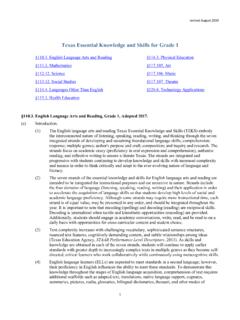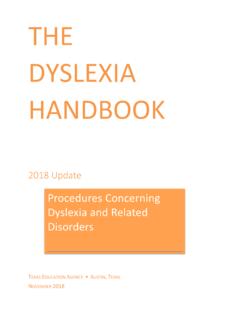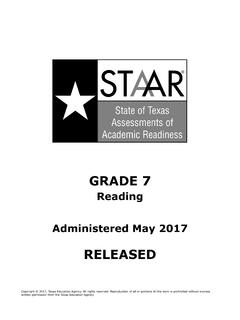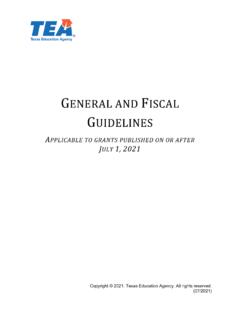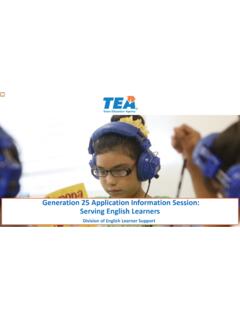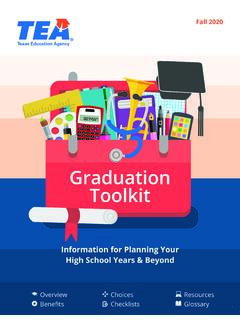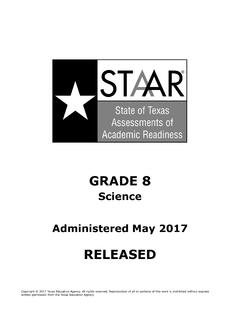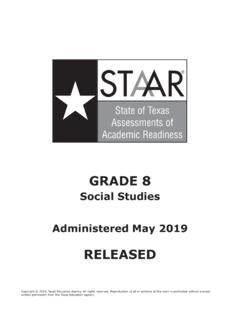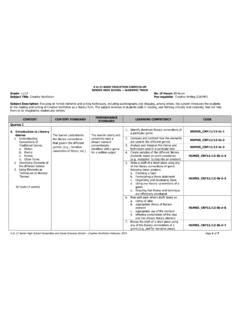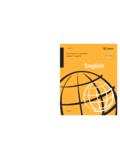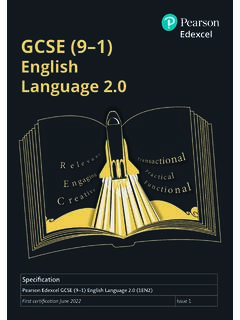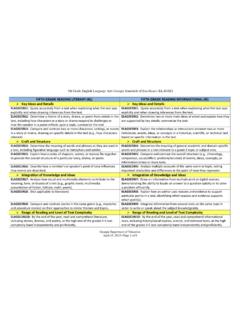Transcription of Texas Essential Knowledge and Skills for Grade 3
1 Revised August 2017 1 Texas Essential Knowledge and Skills for Grade 3 English Language Arts and Reading Mathematics Science Social Studies Languages Other Than English Health Education Physical Education Art Music Theatre Technology Applications English Language Arts and Reading, Grade 3, Beginning with School Year 2009-2010. (a) Introduction. (1) The English Language Arts and Reading Texas Essential Knowledge and Skills (TEKS) are organized into the following strands: Reading, where students read and understand a wide variety of literary and informational texts; Writing, where students compose a variety of written texts with a clear controlling idea, coherent organization, and sufficient detail; Research, where students are expected to know how to locate a range of relevant sources and evaluate, synthesize, and present ideas and information.
2 Listening and Speaking, where students listen and respond to the ideas of others while contributing their own ideas in conversations and in groups; and Oral and Written Conventions, where students learn how to use the oral and written conventions of the English language in speaking and writing. The standards are cumulative--students will continue to address earlier standards as needed while they attend to standards for their Grade . In third Grade , students will engage in activities that build on their prior Knowledge and Skills in order to strengthen their reading, writing, and oral language Skills .
3 Students should read and write on a daily basis. (2) For students whose first language is not English, the students' native language serves as a foundation for English language acquisition. (A) English language learners (ELLs) are acquiring English, learning content in English, and learning to read simultaneously. For this reason, it is imperative that reading instruction should be comprehensive and that students receive instruction in phonemic awareness, phonics, decoding, and word attack Skills while simultaneously being taught academic vocabulary and comprehension Skills and strategies. Reading instruction that enhances ELL's ability to decode unfamiliar words and to make sense of those words in context will expedite their ability to make sense of what they read and learn from reading.
4 Additionally, developing fluency, spelling, and grammatical conventions of academic language must be done in meaningful contexts and not in isolation. (B) For ELLs, comprehension of texts requires additional scaffolds to support comprehensible input. ELL students should use the Knowledge of their first language ( , cognates) to further vocabulary development. Vocabulary needs to be taught in the context of connected discourse so that language is meaningful. ELLs must learn how revised August 2017 2 rhetorical devices in English differ from those in their native language. At the same time English learners are learning in English, the focus is on academic English, concepts, and the language structures specific to the content.
5 (C) During initial stages of English development, ELLs are expected to meet standards in a second language that many monolingual English speakers find difficult to meet in their native language. However, English language learners' abilities to meet these standards will be influenced by their proficiency in English. While English language learners can analyze, synthesize, and evaluate, their level of English proficiency may impede their ability to demonstrate this Knowledge during the initial stages of English language acquisition. It is also critical to understand that ELLs with no previous or with interrupted schooling will require explicit and strategic support as they acquire English and learn to learn in English simultaneously.
6 (3) To meet Public Education Goal 1 of the Texas Education Code, , which states, "The students in the public education system will demonstrate exemplary performance in the reading and writing of the English language," students will accomplish the Essential Knowledge , Skills , and student expectations at Grade 3 as described in subsection (b) of this section. (4) To meet Texas Education Code, (h), which states, ".. each school district shall foster the continuation of the tradition of teaching United States and Texas history and the free enterprise system in regular subject matter and in reading courses and in the adoption of textbooks," students will be provided oral and written narratives as well as other informational texts that can help them to become thoughtful, active citizens who appreciate the basic democratic values of our state and nation.
7 (b) Knowledge and Skills . (1) Reading/Beginning Reading Skills /Phonics. Students use the relationships between letters and sounds, spelling patterns, and morphological analysis to decode written English. Students are expected to: (A) decode multisyllabic words in context and independent of context by applying common spelling patterns including: (i) dropping the final "e" and add endings such as -ing, -ed, or -able ( , use, using, used, usable); (ii) doubling final consonants when adding an ending ( , hop to hopping); (iii) changing the final "y" to "i" ( , baby to babies); (iv) using Knowledge of common prefixes and suffixes ( , dis-, -ly); and (v) using Knowledge of derivational affixes ( , -de, -ful, -able).
8 (B) use common syllabication patterns to decode words including: (i) closed syllable (CVC) ( , mag-net, splen-did); revised August 2017 3 (ii) open syllable (CV) ( , ve-to); (iii) final stable syllable ( , puz-zle, con-trac-tion); (iv) r-controlled vowels ( , fer-ment, car-pool); and (v) vowel digraphs and diphthongs ( , ei-ther); (C) decode words applying Knowledge of common spelling patterns ( , -eigh, -ought); (D) identify and read contractions ( , I'd, won't); and (E) monitor accuracy in decoding. (2) Reading/Beginning Reading/Strategies. Students comprehend a variety of texts drawing on useful strategies as needed.
9 Students are expected to: (A) use ideas ( , illustrations, titles, topic sentences, key words, and foreshadowing clues) to make and confirm predictions; (B) ask relevant questions, seek clarification, and locate facts and details about stories and other texts and support answers with evidence from text; and (C) establish purpose for reading selected texts and monitor comprehension, making corrections and adjustments when that understanding breaks down ( , identifying clues, using background Knowledge , generating questions, re-reading a portion aloud). (3) Reading/Fluency. Students read Grade -level text with fluency and comprehension.
10 Students are expected to read aloud Grade -level appropriate text with fluency (rate, accuracy, expression, appropriate phrasing) and comprehension. (4) Reading/Vocabulary Development. Students understand new vocabulary and use it when reading and writing. Students are expected to: (A) identify the meaning of common prefixes ( , in-, dis-) and suffixes ( , -full, -less), and know how they change the meaning of roots; (B) use context to determine the relevant meaning of unfamiliar words or distinguish among multiple meaning words and homographs; (C) identify and use antonyms, synonyms, homographs, and homophones; (D) identify and apply playful uses of language ( , tongue twisters, palindromes, riddles).
